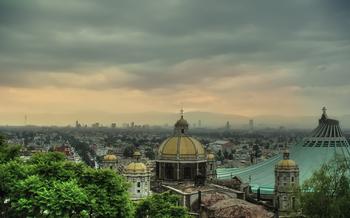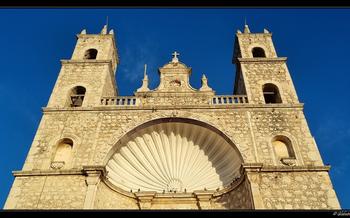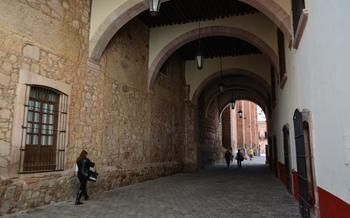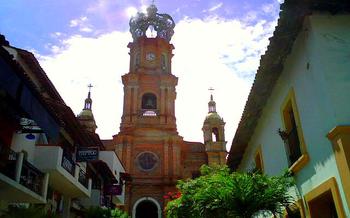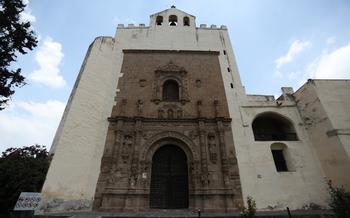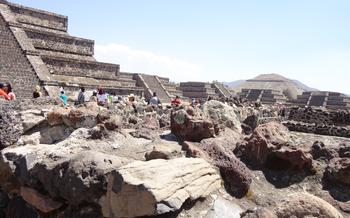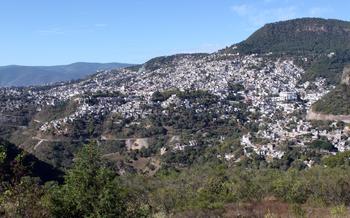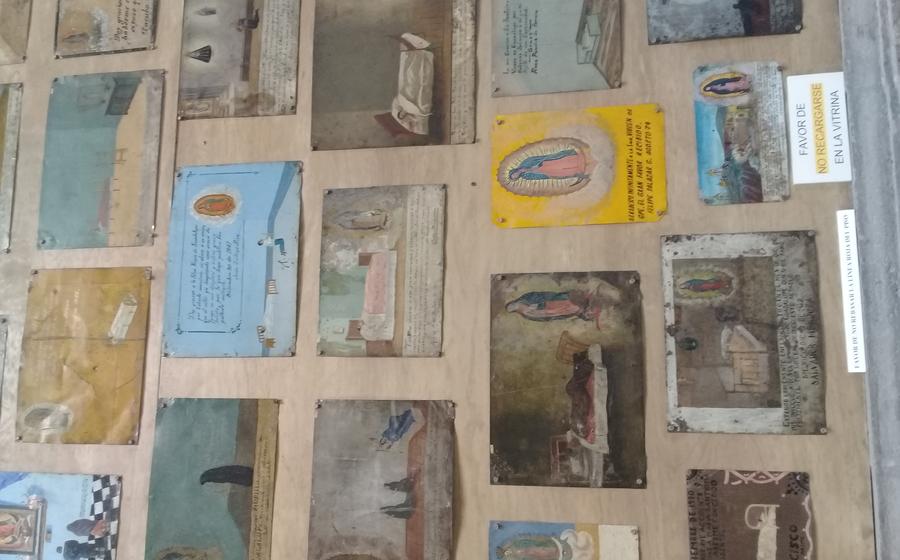
Museo de la Basílica de Guadalupe
- A Monument to the Patroness of Mexico:
- History and Origins of the Basilica
- The Basilica's Stunning Architecture
- The Shrine of the Virgin of Guadalupe
- Pilgrimages and Festivals
- The Basilica's Impact on Mexican Culture
- Exploring the Surrounding Area
- Stories and Legends of the Basilica
- The Basilica's Role in Social Justice
- The Basilica's Ongoing Legacy
- Tips for Pilgrims and Visitors
- Events and Exhibitions
- Insider Tip:
A Monument to the Patroness of Mexico:
The Basilica of Our Lady of Guadalupe, a colossal monument to the patroness of Mexico, holds an unparalleled position in the hearts of Mexicans. Its historical significance is deeply intertwined with the story of Juan Diego, a humble indígena who witnessed miraculous apparitions of the Virgin Mary in 153The basilica, constructed on the site of these apparitions, has become a symbol of faith, hope, and national identity for millions of Mexicans.
The architectural grandeur of the basilica is a testament to its religious and cultural importance. Blending Baroque and Neoclassical elements, the basilica boasts an impressive dome, one of the largest in the Americas, and an intricately carved facade adorned with sculptures depicting scenes from the life of the Virgin Mary. Inside, the basilica's opulent interior features stunning stained glass windows, murals, and gold leaf ornamentation, creating a breathtaking atmosphere of awe and reverence.
For Mexicans, the Basilica of Our Lady of Guadalupe is more than just a religious edifice; it is a spiritual home, a place of pilgrimage and devotion. The Virgin of Guadalupe, affectionately known as "La Guadalupana," holds a special place in Mexican culture, symbolizing unity, strength, and resilience. Her image is deeply embedded in Mexican art, music, literature, and folklore, serving as a source of inspiration and a reminder of the country's rich history and traditions.
History and Origins of the Basilica
The story of the Basilica of Our Lady of Guadalupe begins with Juan Diego, a humble peasant from the village of Cuautitlán. In 1531, while walking to Tenochtitlan (now Mexico City), Juan Diego witnessed an apparition of the Virgin Mary on the hill of Tepeyac. The Virgin instructed him to go to the bishop and ask him to build a church on that site. The bishop, skeptical of Juan Diego's story, asked for proof. Juan Diego returned to Tepeyac and the Virgin instructed him to gather roses from the hilltop, even though it was winter and no roses grew there. Juan Diego did as he was told, and when he opened his cloak before the bishop, the roses spilled out, revealing an image of the Virgin Mary miraculously imprinted on the fabric.
The bishop was convinced and ordered the construction of a church on the site of the apparition. The original basilica, completed in 1555, was a modest structure. However, as the cult of the Virgin of Guadalupe grew in popularity, the church was expanded and rebuilt several times. The current basilica, completed in 1709, is a magnificent Baroque structure that is one of the most important pilgrimage sites in the Americas.
The Basilica of Our Lady of Guadalupe is a place of great significance for Mexicans. It is a symbol of their faith, their history, and their national identity. Millions of pilgrims visit the basilica each year to pay homage to the Virgin of Guadalupe and to seek her intercession. The basilica is also a popular tourist destination, and visitors from all over the world come to admire its stunning architecture and to learn about its rich history.
The Basilica's Stunning Architecture
The Basilica of Our Lady of Guadalupe stands as a testament to the fusion of Baroque and Neoclassical architectural styles. Its grandeur is immediately apparent as visitors approach the basilica, with its imposing facade adorned with intricate sculptures and reliefs depicting scenes from the life of the Virgin Mary.
The basilica's most striking feature is its massive dome, one of the largest in the Americas. Its intricate design, featuring ribs and coffers, creates a sense of awe and wonder. The interior of the dome is adorned with beautiful frescoes and paintings, adding to the basilica's visual splendor.
The basilica's facade is equally impressive, showcasing a harmonious blend of Baroque and Neoclassical elements. The grand entrance, flanked by two bell towers, features intricate carvings and statues of saints and angels. The facade is further embellished with decorative moldings, cornices, and balustrades, creating a sense of elegance and refinement.
Inside the basilica, visitors are greeted by a breathtaking array of stained glass windows, murals, and gold leaf ornamentation. The stained glass windows depict scenes from the Bible and the life of the Virgin Mary, casting a colorful glow throughout the interior. The murals, painted by renowned Mexican artists, depict religious scenes and historical events, adding to the basilica's artistic and cultural significance.
Gold leaf ornamentation adorns the altar, the pulpit, and the various chapels within the basilica. The intricate designs and shimmering gold create a sense of opulence and reverence, enhancing the basilica's sacred atmosphere.
The Shrine of the Virgin of Guadalupe
Within the heart of the Basilica of Guadalupe lies the sacred Shrine of the Virgin of Guadalupe, a place of profound reverence and spiritual connection for millions of pilgrims. The shrine is adorned with intricate gold leaf ornamentation, creating an ethereal ambiance that befits the miraculous image it enshrines. The image of the Virgin of Guadalupe, depicted on a tilma (cloak) of humble Juan Diego, is the centerpiece of the shrine. It is believed to have been miraculously imprinted on the tilma in 1531, and its preservation over the centuries remains a source of awe and wonder. Pilgrims from all walks of life flock to the shrine to pay homage to the Virgin, leaving offerings of flowers, candles, and personal belongings as tokens of their devotion. The stories of miracles attributed to the Virgin's intercession are interwoven with the history of the shrine, creating a palpable sense of hope and spiritual renewal within its walls.
Pilgrimages and Festivals
The Basilica of Our Lady of Guadalupe is a major destination for pilgrimages from all over Mexico and beyond. Millions of pilgrims visit the basilica each year, especially during the annual feast day of the Virgin of Guadalupe, celebrated on December 12th. The feast day is a national holiday in Mexico, and the basilica is packed with pilgrims from all walks of life who come to pay homage to the Virgin and to celebrate her miraculous appearance to Juan Diego.
The festivities surrounding the feast day are a vibrant display of Mexican culture and devotion. Colorful processions wind their way through the streets of Mexico City, carrying images of the Virgin and accompanied by traditional music and dance. Pilgrims from all over the country gather in the basilica to participate in special masses and to offer their prayers and petitions to the Virgin. The atmosphere is electric, with the sound of prayers and hymns filling the air and the scent of incense wafting through the basilica.
For many pilgrims, the pilgrimage to the Basilica of Our Lady of Guadalupe is a deeply personal and spiritual experience. They come to the basilica to seek the Virgin's intercession, to give thanks for her blessings, or simply to be in her presence. The basilica is a place of hope and healing, where pilgrims can find solace and strength in their faith.
The Basilica's Impact on Mexican Culture
The Basilica of Our Lady of Guadalupe has had a profound impact on Mexican culture, shaping its art, music, literature, and folklore. The Virgin of Guadalupe, enshrined within the basilica, has become a symbol of national identity and unity, deeply embedded in the hearts of Mexicans. Her image can be found everywhere, from churches and homes to public spaces and commercial products.
The basilica has also influenced Mexican religious traditions and spirituality. The cult of the Virgin of Guadalupe has become an integral part of Mexican Catholicism, with millions of pilgrims visiting the basilica each year to pay homage to the Virgin and seek her intercession. The basilica has played a key role in promoting Marian devotion and spreading the message of love, hope, and compassion throughout Mexico.
Exploring the Surrounding Area
Beyond the basilica's sacred walls, the surrounding neighborhood offers a wealth of attractions and experiences for visitors to explore. A short walk from the basilica stands the Templo Expiatorio del Santísimo Sacramento, an awe-inspiring neo-Gothic masterpiece. Its intricate facade, soaring spires, and stained-glass windows are a testament to the architectural prowess of the late 19th century.
History buffs will delight in exploring the Plaza de las Tres Culturas, located just a few blocks away. This historic square showcases the fusion of three distinct cultures – Aztec, Spanish, and modern Mexican – that have shaped the identity of Mexico City. The plaza is home to pre-Columbian ruins, colonial-era buildings, and contemporary structures, providing a glimpse into the city's rich and layered past.
For those seeking culinary delights, the surrounding area offers a tantalizing array of dining options. From traditional Mexican cuisine to international fare, there's something to satisfy every palate. Indulge in freshly made tortillas, savor the flavors of pozole, or tempt your sweet tooth with churros. The vibrant markets and street stalls offer a unique opportunity to sample local delicacies and immerse yourself in the city's culinary scene.
Whether you're interested in history, architecture, or gastronomy, the area surrounding the Basilica of Our Lady of Guadalupe promises an enriching and unforgettable experience. Take the time to explore its hidden gems and discover the many wonders that await beyond the basilica's doors.
Stories and Legends of the Basilica
The Basilica of Our Lady of Guadalupe is steeped in local legends and stories that have been passed down through generations. Pilgrims and visitors often share miraculous events and healings attributed to the Virgin's intercession, creating a sense of awe and reverence within the basilica's walls.
One of the most famous legends tells the story of a young man who was critically ill and close to death. His family members brought him to the basilica, where they prayed fervently to the Virgin of Guadalupe for his recovery. Miraculously, the young man's health improved, and he eventually made a full recovery, attributing his healing to the Virgin's intervention.
Another popular story recounts the experience of a woman who had lost her way in the desert. After wandering for days without food or water, she stumbled upon the basilica and collapsed at the foot of the Virgin's image. As she lay there, exhausted and dehydrated, she felt a gentle touch on her shoulder. When she opened her eyes, she saw the Virgin of Guadalupe standing before her, offering her a cup of water. The woman drank the water and immediately felt refreshed and revitalized, finding her way back home safely.
These stories, passed down from generation to generation, contribute to the basilica's reputation as a place of hope and spiritual transformation. Pilgrims from all walks of life come to the basilica seeking solace, healing, and guidance, believing in the Virgin's miraculous powers and the transformative power of the basilica itself.
The Basilica's Role in Social Justice
Beyond its religious and cultural significance, the Basilica of Guadalupe also plays an active role in promoting social justice and serving the community. The basilica is committed to addressing the needs of the poor and marginalized, and it actively participates in various charitable initiatives.
For example, the basilica provides food, shelter, and medical assistance to those in need. It also runs educational programs for children from low-income families and offers job training and counseling services to help people find employment.
The basilica is also a strong advocate for human rights, social equality, and peace. It has spoken out against injustice and discrimination, and it has worked to promote dialogue and understanding between different groups.
In addition, the basilica is committed to interfaith dialogue and cooperation. It works with other religious institutions to promote peace and understanding, and it participates in interfaith initiatives to address social issues such as poverty and climate change.
Through its social justice initiatives, the Basilica of Guadalupe demonstrates its commitment to serving the community and making a positive impact on society.
The Basilica's Ongoing Legacy
The Basilica of Our Lady of Guadalupe stands as an enduring symbol of faith, cultural heritage, and national identity in Mexico. Its legacy extends far beyond its religious significance, shaping the very fabric of Mexico City and the nation as a whole. The basilica's enduring allure continues to draw pilgrims and visitors from around the world, who come to witness its architectural grandeur, pay homage to the Virgin of Guadalupe, and seek spiritual solace within its sacred walls.
The basilica's ongoing relevance is evident in its commitment to preserving its heritage while embracing modern initiatives. Restoration and conservation efforts ensure that the basilica's architectural integrity and artistic treasures are maintained for future generations. At the same time, the basilica embraces technology to enhance the visitor experience, providing virtual tours, interactive exhibits, and digital resources to deepen understanding and engagement with its history and significance.
The basilica's impact extends beyond its physical presence. Its role in promoting social justice, interfaith dialogue, and peacebuilding initiatives makes it a beacon of hope and inspiration. Through its charitable work, advocacy for marginalized communities, and promotion of human rights, the basilica embodies the values of compassion, equality, and understanding.
As the basilica looks to the future, it continues to play a vital role in shaping Mexican society. Its enduring legacy as a religious, cultural, and historical landmark ensures that the Basilica of Our Lady of Guadalupe will remain a source of inspiration, devotion, and national pride for generations to come.
Tips for Pilgrims and Visitors
Whether you're a pilgrim or a curious visitor, here are some practical tips to make the most of your visit to the Basilica de Guadalupe and the Museo de la Basílica de Guadalupe:
- Pilgrims: Pack light but bring essentials like comfortable shoes, a hat, and a water bottle. Dress respectfully and avoid shorts or tank tops. Familiarize yourself with local customs and traditions to show respect for the sacredness of the site.
- Visitors: Photography is allowed inside the basilica, but be mindful of others and avoid using flash. For the best photo opportunities, visit during the golden hours of sunrise or sunset. Remember, the basilica is an active place of worship, so be respectful of those praying.
- Everyone: The basilica is wheelchair accessible and offers guided tours in various languages. Check the basilica's website or ask at the information desk for details. Maintain a respectful demeanor and avoid loud conversations or disruptive behavior within the basilica's sacred spaces.
Remember, a visit to the Basilica de Guadalupe and the Museo de la Basílica de Guadalupe is a unique opportunity to immerse yourself in Mexican history, culture, and spirituality. Embrace the experience with an open heart and mind, and you'll leave with a deeper understanding of this iconic landmark and its significance to the Mexican people.
Events and Exhibitions
The Museo de la Basílica de Guadalupe regularly hosts a variety of events and exhibitions that enhance the visitor experience and provide deeper insights into the basilica's history, art, and significance. These events may include:
-
Temporary Exhibitions: The museum showcases rotating exhibitions featuring religious artifacts, historical documents, and contemporary artworks related to the basilica and the Virgin of Guadalupe. These exhibitions offer visitors a chance to explore different aspects of the basilica's story and its impact on Mexican culture.
-
Concerts and Performances: The basilica's impressive acoustics and grand setting make it an ideal venue for musical performances. Visitors can attend concerts featuring sacred music, traditional Mexican music, and international classical music.
-
Conferences and Lectures: The museum hosts conferences, lectures, and symposia on various topics related to the basilica, the Virgin of Guadalupe, and Mexican religious history. These events bring together scholars, historians, and religious leaders to share their knowledge and insights with the public.
-
Special Events: Throughout the year, the basilica organizes special events such as guided tours, workshops, and pilgrimages. These events provide visitors with unique opportunities to learn more about the basilica, its traditions, and its spiritual significance.
To stay informed about upcoming events and exhibitions, visitors can check the basilica's website, social media channels, or inquire at the museum's information desk. By participating in these events, visitors can gain a deeper understanding of the basilica's rich history and its ongoing role in Mexican society.
Insider Tip:
For a truly immersive experience, visit the basilica during one of the many festivals or celebrations that take place throughout the year. The most significant event is the annual feast day of the Virgin of Guadalupe on December 12th, which attracts millions of pilgrims from all over the world. During this time, the basilica is transformed into a sea of color and devotion, with processions, traditional dances, and musical performances filling the air. It's an unforgettable opportunity to witness the deep faith and cultural traditions that surround the basilica and the Virgin of Guadalupe. Don't miss the chance to immerse yourself in this vibrant celebration and experience the basilica at its most extraordinary.

